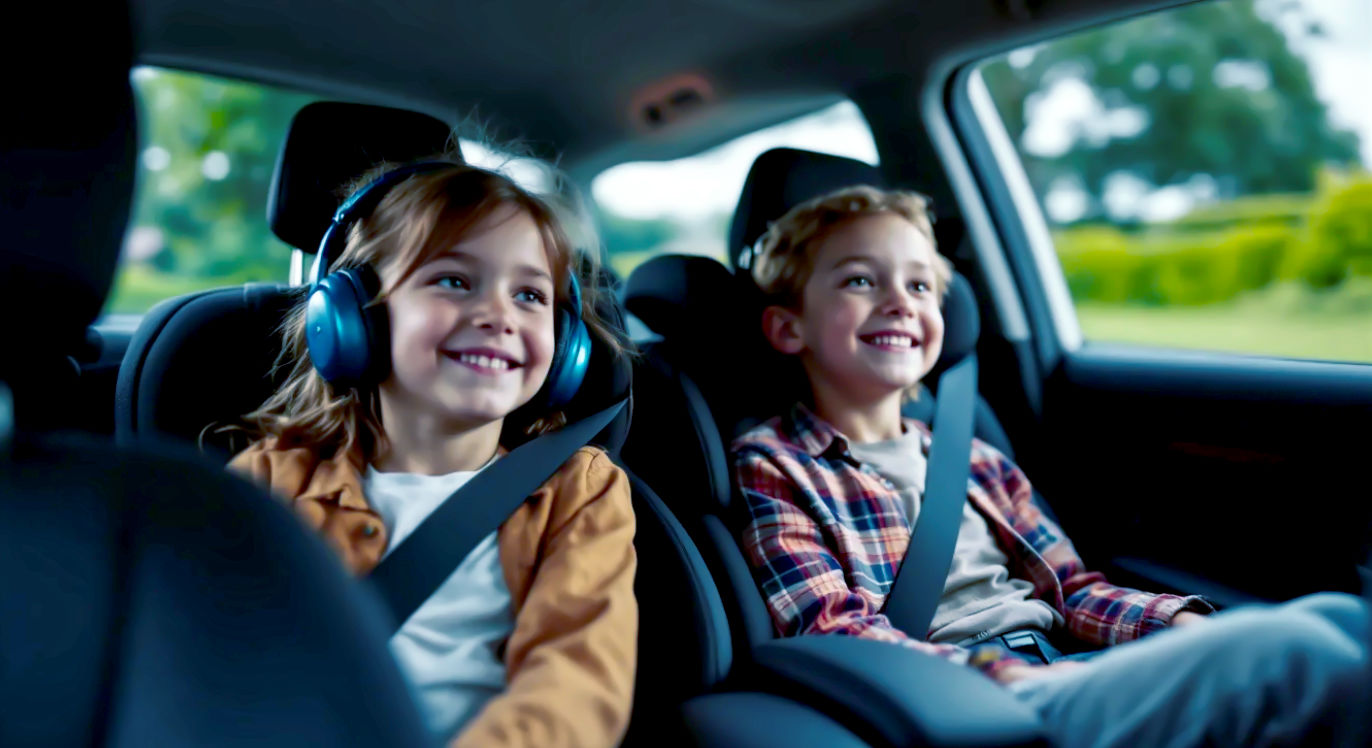The Guide to Car Headrest Video Players: Your Secret to Peaceful Family Road Trips
Say goodbye to “Are we there yet?”. Our definitive guide explains every type of headrest video player, with UK legal advice and installation tips.

This post may contain affiliate links. If you make a purchase through these links, we may earn a commission at no additional cost to you.
Let’s paint a picture. You’re on the M5, somewhere past Bristol, heading for that lovely cottage in Cornwall. The sat-nav says you’ve still got two hours to go. The sun is shining, the boot is packed to the brim, and in the back, a small voice pipes up for the seventeenth time: “Are we there yet?”
It’s the soundtrack to the great British family holiday, isn’t it? That, and the squabbling over who gets to choose the music. For decades, parents have relied on a patchwork of solutions: I Spy, travel sweets, and the faint hope the kids might just fall asleep. But in the 21st century, there’s a better way. A quieter, more harmonious way.
Enter the car headrest video player.
This isn’t about plugging your kids into a screen for hours on end. It’s about reclaiming your sanity on long journeys. It’s about turning the car from a cramped box of boredom into a mobile cinema, where traffic jams on the M25 become an opportunity to finish a film. It’s the difference between arriving at your destination frazzled and arriving ready for fun.
But where do you start? The market is flooded with options, technical jargon, and a dizzying array of features. That’s where this guide comes in. We’re going to demystify everything. From choosing the right system for your family to installing it safely and legally, we’ll cover it all. By the end, you’ll be an expert, ready to transform your family’s travel experience forever. So, buckle up, and let’s get started.
What Exactly is a Car Headrest Video Player?
Before we dive into the deep end, let’s get the basics right. What are we actually talking about?
In simple terms, a headrest video player is a small screen that attaches to the back of your car’s front seats, designed for rear passengers to watch films, TV shows, or even play games. Think of it as a personal TV for the backseat.
They’re a neat, self-contained solution. Unlike balancing an iPad on a lap or wedging a phone into a cup holder, these systems are securely mounted and built for the car environment. They draw power from the car itself, so you never have to worry about a battery dying ten minutes before the big finale of Frozen.
Most systems come as a pair of screens, because if one child has a screen, you can bet the other will want one too. They’re the modern-day peace treaty for warring siblings in the back.
The Two Main Flavours: Strap-On vs. Full Replacement
When you start shopping, you’ll quickly notice there are two main types of headrest player. The one you choose depends on your budget, your car, and how confident you are with a bit of DIY.
1. The Universal Tablet-Style Player (The Strap-On)
This is by far the most popular and practical choice for most families in the UK.
- What it is: A slim, tablet-like screen that comes with a special bracket. This bracket clamps onto the metal posts of your front seat headrest. The screen then just clips onto the bracket. It’s simple, secure, and doesn’t permanently alter your car.
- The Pros:
- Easy to Install: You can have a twin-screen system up and running in about 15 minutes. No tools needed.
- Affordable: A good quality twin-screen DVD or media player system will typically cost between £150 and £400.
- Portable: You can easily move them between cars. If you’re selling your car, you just unclip them and take them with you.
- The Cons:
- Looks Aftermarket: They don’t blend in quite as seamlessly as a factory-fitted option. You’ll have a few wires running to the power socket.
- Universal Isn’t Always Universal: While they fit most cars, some vehicles with ‘active headrests’ (designed to move in a crash) or non-standard headrest posts can be a problem. It’s always best to check your car first.
2. The Integrated Headrest Replacement
This is the premium option, for those who want a professional, factory-fitted look.
- What it is: You buy a whole new headrest with the screen and player already built inside. You remove your car’s original headrest and slot this one in its place.
- The Pros:
- Seamless Look: It looks fantastic. All the wires are hidden down through the seat, so there’s no clutter. It looks like it was fitted at the factory.
- Potentially More Secure: Because it’s part of the seat, it’s incredibly sturdy.
- The Cons:
- Expensive: These systems cost significantly more than their strap-on cousins.
- Tricky Installation: Hiding the wires properly involves removing seat trim and can be a fiddly job. Many people opt for professional installation, which adds to the cost.
- Matching Issues: You need to match the leather or fabric colour and texture to your car’s interior, which isn’t always easy.
- Safety Concerns: You are replacing a piece of your car’s safety equipment. It’s vital to ensure the replacement meets safety standards.
Our Verdict: For 95% of families, the universal tablet-style player is the way to go. It offers the best balance of price, convenience, and features.
A Quick Trip Back in Time: The Evolution of In-Car Entertainment
To appreciate how good we have it now, it’s worth remembering what car journeys used to be like. For a long time, the only entertainment was the world outside the window and your dad whistling slightly out of tune.
The journey to our modern mobile cinemas started in the 1930s with the first, crackly AM radios—a luxury few could afford. The real revolution for families came in the 1970s and 80s with the cassette player. Suddenly, you could have your own soundtrack for the road. It meant carefully curated mixtapes and the constant threat of the player chewing up your favourite tape, requiring a delicate rescue operation with a pencil.
The 90s brought the skip-free bliss of the CD player, and car audio got a serious upgrade. But vision? That was still the stuff of science fiction or limousines on TV.
The first aftermarket in-car video systems appeared in the late 90s. They were usually huge, clunky CRT screens that folded down from the roof, cost a fortune, and were often paired with a separate VHS or DVD player hidden under a seat.
It was the explosion of affordable LCD flat-screen technology in the 2000s that changed everything. Screens got thinner, cheaper, and better. This paved the way for the sleek, simple, and affordable headrest systems we have today. They’ve transformed the great British road trip from an endurance test into a genuinely enjoyable part of the holiday.
Beyond Boredom: How Headrest Players Changed the Family Car
It might seem like just a gadget, but the humble headrest player has had a real impact on the dynamic of family travel.
For one, it has largely spelled the end of traditional car games. The chorus of “I spy with my little eye…” has been replaced by the muffled theme tune of Peppa Pig or the dramatic sound effects of a superhero movie. Is this a loss? Some would say so. It can lead to less interaction, with each family member lost in their own world.
However, any parent who has endured a five-hour drive with fighting children will tell you it’s a price worth paying. The primary benefit is undeniable: peace and quiet. A good film can absorb even the most restless child, preventing the arguments and whining that can turn a car journey into a nightmare. It allows the adults in the front to chat, listen to their own podcast, or simply enjoy the drive without being a referee.
In essence, these devices help turn the car into a ‘second living room’. They contribute to a more comfortable, personalised, and less stressful environment. While it’s important to balance screen time with conversation and looking at the scenery, on a long slog up the M6, they are an absolute godsend.
Under the Bonnet: Understanding the Techy Bits
Alright, let’s get into the details. Understanding a few key technical terms will help you choose the best system and avoid disappointment. Don’t worry, we’ll keep it simple.
Screens: Your Window to the Action
- Resolution: This is how many pixels (tiny dots) make up the picture. More pixels mean a sharper, clearer image. The standard for most decent players today is 1024 x 600 pixels. Anything less will look a bit fuzzy. Some premium models offer HD (1920 x 1080), which is fantastic but probably overkill for a 10-inch screen viewed by a child.
- Screen Size: Measured diagonally, like a TV. The most common sizes are 9 inches and 10.1 inches. Both are plenty big enough for backseat viewing. Bigger isn’t always better, as a massive screen can feel a bit overwhelming in a smaller car.
- Touchscreen vs. Buttons: Most modern players are touchscreen, which is very intuitive for kids who are used to tablets and phones. However, they also usually come with a remote control, which can be easier for a parent in the front passenger seat to operate.
Power: Keeping the Show on the Road
The great thing about dedicated car video players is that they run off the car’s power.
- 12V Cigarette Lighter Socket: This is the standard method. The system will come with a plug that splits to power both screens. It’s incredibly simple: just plug it in and you’re good to go. The only downside is a wire trailing from the dashboard.
- Hardwiring: For a cleaner, permanent installation, you can have the player wired directly into your car’s fuse box. This hides all the cables but is a job for a professional auto-electrician or a very confident DIYer.
- Built-in Battery: Some models come with a rechargeable battery, which typically lasts for 2-3 hours. This is a brilliant feature. It means the film doesn’t stop every time you turn the engine off at a petrol station. It also means you can take the player out of the car and use it in your holiday cottage.
Sound: Hearing the Action (Without Driving You Mad)
You have a few options for audio, which is crucial for keeping the driver sane.
- Built-in Speakers: Every player has them. Honestly, they’re usually not great – a bit tinny and weak. They’re fine in a pinch, but you have better options.
- Wired Headphones: The simplest and most reliable method. Each screen will have a standard 3.5mm headphone jack, just like a phone or laptop. Give the kids a pair of headphones each, and you get blessed silence in the front.
- IR (Infrared) Wireless Headphones: This is a fantastic, wire-free upgrade. The player has a small IR transmitter, and you buy special IR headphones that receive the signal. It means no tangled cables for kids to get caught in. Most twin-screen systems will come with two pairs.
- FM Transmitter: This feature lets the player broadcast the audio over a short-range FM frequency. You then tune your car radio to that frequency, and the film’s sound will play through your car’s main speakers. It’s great for when the whole family wants to listen, creating a proper ‘surround sound’ experience.
The Brains of the Operation: What Can It Play?
How you get your films and shows onto the screen is a key consideration.
- DVD Player: The old classic. Many systems have a built-in DVD player in one or both of the screens. It’s simple – just pop the disc in. The downside is that you have to lug a collection of plastic cases around with you. Make sure you get a region-free player, so it can play DVDs you might have bought on holiday in America, for example.
- USB Port / SD Card Slot: This is the modern, more flexible option. You can load dozens of films onto a single, tiny USB stick or SD card. Before your trip, just copy video files from your computer. This is much more convenient than carrying a pile of DVDs.
- HDMI Input: This is a game-changer. An HDMI port allows you to connect other devices to the screen, like a Google Chromecast, an Amazon Fire Stick, a games console, or even your smartphone (with the right adapter). This opens up a world of possibilities, allowing you to stream Netflix or Disney+ on the go (you’ll need to use your phone as a Wi-Fi hotspot).
Twin Screens: Sharing the Fun
Most families will opt for a twin-screen system. These work in a clever way.
- Master & Slave: Usually, one screen is the ‘master’ (or Player A). This is the one with the DVD slot and USB port. The other screen is the ‘slave’ (Player B), which is just a monitor. You connect them with an included AV cable.
- Shared Viewing: You put a DVD in the master unit, and the film plays on both screens simultaneously. Perfect for two kids who want to watch the same thing.
- Independent Viewing: Many modern systems also allow each screen to play from its own source. For example, one child could watch a DVD on the master screen, while the other watches a different film from a USB stick plugged into the slave screen. This is the ultimate solution for preventing arguments over what to watch.
Your Buyer’s Guide: Choosing the Perfect System for Your Family
Okay, you’re convinced. But with so many models out there, how do you pick the right one? Here’s a checklist of things to consider.
1. Who is Watching?
The age of your children is a big factor.
- Toddlers and Young Children: Simplicity is key. A basic DVD player with a touchscreen is ideal. They can be happy watching the same film on repeat, so a system that shares one movie across two screens is perfect.
- Older Kids and Teenagers: They will want more choice and flexibility. Look for a system that allows independent viewing on each screen. Features like a USB port and, crucially, an HDMI input will be a big hit, allowing them to connect their own devices.
2. Check Your Car’s Headrests
Before you click ‘buy’, go out to your car. Most headrests have two metal posts that you can raise and lower, and this is what universal brackets attach to.
- Measure the distance between the posts.
- Measure the diameter of the posts.
- Check the product specifications to ensure the bracket will fit. Most are adjustable, but it pays to be sure.
- Warning for Volvo/BMW/Mercedes owners: Some premium cars, particularly Volvos, have ‘active headrests’ that are part of the car’s whiplash protection system. They are often sealed units with no visible posts and cannot be removed. If you have a car like this, a headrest replacement is not an option, and you’ll need to find a strap-on system with a mounting solution that can wrap around the entire headrest itself, rather than clamping to the posts.
3. DVD, Digital, or Both?
Think about how you consume media at home.
- If you have a huge DVD collection, a system with a disc player makes sense.
- If you’ve gone fully digital and download or stream everything, prioritise models with excellent USB support and an HDMI input.
- The best choice for most is a ‘combi’ system that offers both a DVD player and USB/HDMI ports. This gives you the best of both worlds.
4. Set a Budget
You don’t need to spend a fortune.
- £100-£150: Will get you a basic but functional single-screen or a very simple twin-screen DVD player.
- £150-£300: This is the sweet spot. In this range, you’ll find high-quality 10-inch twin-screen systems with DVD, USB, HDMI, and often included IR headphones. Brands like Vanku, Wonnie, and Naviskauto are popular and well-regarded in this bracket.
- £300+: Here you’re looking at premium features, larger HD screens, built-in Android systems, or integrated headrest replacement units.
Let’s Get It Fitted: A Simple Installation Guide
You’ve bought your new strap-on system. It’s arrived. Don’t be intimidated by the box of bits. Installing it is easier than building a piece of IKEA furniture.
Step 1: Unbox and Check Everything Lay all the parts out. You should have: two screens, two mounting brackets, a 12V power cable, an AV link cable, remote controls, and maybe some headphones. Turn the screens on to make sure they work before you start.
Step 2: Attach the Mounting Brackets Go to your car. Adjust one of the front headrests to a comfortable height. The bracket will have two arms that clamp around the headrest’s metal posts. Loosen the thumbscrews, position the bracket, and tighten them firmly. It should be solid, with no wobble. Repeat for the other seat.
Step 3: Clip the Screens On The back of each screen will have a slot or connector that slides securely onto the mounting bracket. You should hear a satisfying ‘click’ when it’s locked in place. Give it a gentle tug to make sure it’s secure.
Step 4: Run the Wires This is the bit that makes the difference between a messy setup and a neat one.
- Plug the power and AV link cables into the screens.
- Tuck the wires down the side of the seat, between the cushion and the plastic trim.
- Run the wires under the floor mats to the centre console.
- Plug the main 12V adapter into your car’s cigarette lighter socket.
- Use a few small cable ties to bundle any excess wire together and tuck it away under a seat.
Step 5: Power On and Test Turn your car’s ignition on. The screens should light up. Pop in a DVD or a USB stick and check that you have picture and sound on both screens. Test the remote controls and headphones.
And that’s it! You’re ready to hit the road.
Safety First: The Legal and Practical Rules of the Road
This is the most important section of the guide. Getting this wrong is not only dangerous but could also land you in trouble with the law.
The UK Law on In-Car Screens
The law is very clear. According to the Road Vehicles (Construction and Use) Regulations 1986, it is illegal to have a screen displaying moving images visible to the driver while the vehicle is in motion.
This doesn’t apply to satellite navigation, but it absolutely applies to films and TV shows.
Happily, headrest video players are designed to comply with this perfectly. They are positioned behind the driver and front passenger, intended only for backseat viewing. The driver cannot see them. So, as long as you install them correctly on the rear of the headrests, you are fully compliant with UK law.
Practical Safety Tips
- Secure Mounting is Non-Negotiable: The single biggest safety risk is the screen coming loose in a sudden stop or, worse, an accident. When you fit the bracket, make sure it is rock solid. After a week or so of use, check it again and re-tighten if necessary. A flying screen can cause serious injury.
- Tidy Cables: Don’t leave wires trailing where people can get their feet caught when getting in and out of the car. Tuck them away safely.
- Don’t be a Distracted Driver: As the driver, your job is to drive. Delegate the operation of the video player to the front-seat passenger or get everything set up before you pull away. Don’t be tempted to reach back and fiddle with settings while you’re on the motorway.
Common Problems and Quick Fixes
Even the best tech can have a wobble. Here are some common gremlins and how to sort them out.
- “It won’t turn on!”
- Is the car’s ignition on? Most 12V sockets only work when the car is on.
- Check the little red light on the 12V plug is lit. If not, the plug itself might have a small glass fuse inside. Carefully unscrew the tip – you can buy replacements at places like Halfords.
- “The sound from the FM transmitter is fuzzy.”
- You’re likely getting interference from a local radio station. Go into the player’s settings and try broadcasting on a different frequency (e.g., move from 88.1 MHz to 107.5 MHz). Find a spot on the dial that is just static.
- “My video file on the USB stick won’t play.”
- This is almost always a file format issue. Check the player’s manual for the list of supported formats (e.g., MP4, AVI, MKV). Your file might be in an unsupported format. The easy solution is to use a free computer program like HandBrake to convert the video to a standard MP4 file.
- “The slave screen is just black.”
- Check the AV link cable is securely plugged in at both ends.
- Make sure you have selected the correct ‘source’ or ‘AV in’ on the slave screen’s menu.
The Future: What’s Next for Backseat Entertainment?
The world of tech moves fast. So, what does the future hold?
- The Slow Death of the DVD: Physical media is on its way out. Future models will likely ditch the disc player entirely in favour of more USB ports, bigger internal storage, and better smart features.
- The Rise of the Smart Screen: We are already seeing more headrest systems with the Android operating system built-in. This effectively turns the screen into a dedicated tablet for your car. It can connect to your phone’s Wi-Fi hotspot, allowing kids to stream directly from Netflix, Disney+, BBC iPlayer, and YouTube.
- Competition from Tablets: The biggest rival to a dedicated headrest player is, of course, an Apple iPad or Android tablet in a simple headrest mount.
- Tablet Pros: Versatile (can be used for games, homework, etc.), familiar interface for kids.
- Dedicated Player Pros: No worries about battery life, less distracting (no notifications or tempting games), much simpler to use, and often cheaper for a twin-screen setup. They are built for one job and do it brilliantly without fuss.
- Deeper Car Integration: In new, high-end cars, we’ll see this technology become a standard, factory-fitted option, seamlessly integrated with the car’s main infotainment system and controls.
Even with the rise of tablets and smart systems, the simple, reliable, plug-and-play headrest video player will have a place for years to come. It’s a dedicated, distraction-free tool that solves a common problem with elegant simplicity.
Conclusion: The Journey is Part of the Adventure
A family car journey doesn’t have to be a test of endurance. With the right preparation and the right technology, it can be a smooth, enjoyable, and peaceful experience for everyone. A car headrest video player is more than just a gadget; it’s an investment in your peace of mind. It’s a tool that allows you to manage your children’s boredom, reduce conflict, and start your holiday the moment you pull off the driveway.
By understanding the different types, knowing what features to look for, and installing your system safely, you can transform your car into the ultimate family travel machine. The silence from the backseat won’t be an awkward one; it’ll be the golden, contented silence of children happily lost in a story, while you enjoy the open road ahead. And you’ll finally be able to answer that age-old question with a smile: “Not long now.”
Further Reading
To continue your research, we recommend these highly respected resources:
- What Car?: For professional reviews on car accessories and technology.
- Auto Express: A trusted source for product tests and in-car tech news.
- The RAC: Offers excellent advice on driving laws and road safety in the UK.






